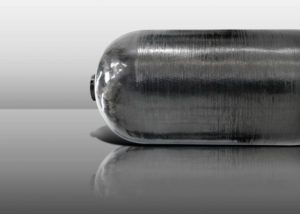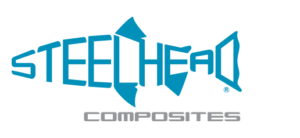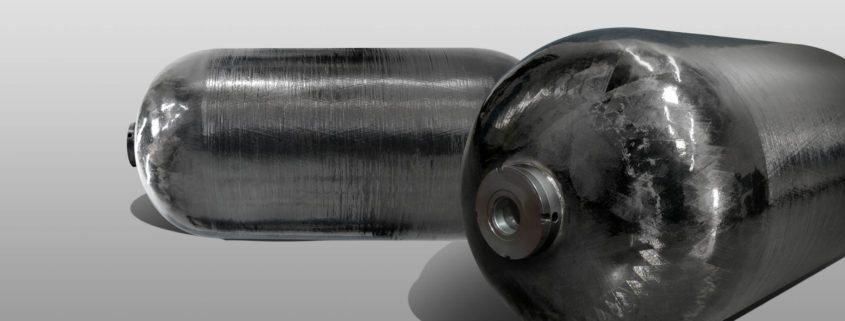Steelhead Pivots to Medical

Hydrogen Composite Vessel
Steelhead Medical Grade Oxygen for COVID-19 Ventilation Treatment
— A Manufacturing Pivot —
Steelhead Composites Inc. (Steelhead; established 2012[1]) is a leader in lightweight, reliable and safe gas storage vessels. We offer dozens of products, in various formats and sizes for nearly every market – automotive, aerospace, energy, marine and others. Notably, we do not serve the medical market owing to a belief that large liquid oxygen and small personal bottles were enough to satisfy needs. The coronavirus (2019-nCoV or COVID-19) pandemic has illuminated medical supply vulnerabilities that remained mostly untested since the 1918 influenza outbreak. Until now, oxygen supply vulnerability concerns centered on other mass casualty events and disasters. Regardless this represents an area of need that is now exacerbated, and a timely response is critical to save hundreds of thousands of lives across our cities, states, nation and planet.
COVID-19 is commonly expressed in humans – more than 15 percent of ill patients – as severe acute respiratory syndrome (SARS). Life support and recovery is based on medical-grade oxygen ventilation. Because of the rapid growth rate leading to an unprecedented number of patients and, predictions for continued trends, an overwhelmed medical industry is seeking support at all levels. Medical professionals are resorting to triage decisions involving patient life and death; decisions of which patients to treat based on survivability probabilities. Human live casualty numbers are large and growing, necessitating a swift and concerted humanitarian response.
Public responses notably include the rapid establishment of pop-up medical centers to meet patient numbers; for example, the conversion of facilities like the Javits Center, New York City, New York. Also, agencies, organizations and units are leading efforts to leverage private sector assets for medical needs. Examples include products for diagnosis, therapy and immunization; various protective equipment; and treatment and recovery supplies. This prominently includes ventilator units that rely on medical-grade oxygen.
Steelhead is performing a manufacturing base pivot. We are establishing a cleaning facility to provide storage products that meet specifications for medical oxygen administration to humans (and/or animals). This will be used to meet needs for COVID-19, recurrence or other outbreaks and; reduce known and existing oxygen-supply vulnerabilities for numerous mass casualty events and disasters. We are expanding our world-class manufacturing capabilities to produce medical oxygen containers and, SAVE LIVES.
Significance of the Opportunity. Since COVID-19 emerged, hospitals have consistently reported shortages of ventilators, personal protective equipment (PPE), diagnostic tests and drugs. Medical professionals are now reporting oxygen supplies as the latest choke point in efforts to battle this pandemic. COVID-19 is predominantly a SARS disease, and as the rate of infection rises, and hospitalizations follow suit, there is a direct increase in demand for medical oxygen. Most patients hospitalized with COVID-19 infections, even those not sick enough to be placed on ventilators or continuous positive airway pressure (CPAP) machines, display impaired lung function and require supplemental oxygen. As patient numbers increase, the amount of oxygen required is threatening to exhaust supply, which leaves them scrambling to keep pace with demand.
“Oxygen supply problems (are) ‘the new PPE’ warn hospital bosses”[2]
Oxygen consumption is not usually considered a potential hazard for hospitals, as the majority of patients require no oxygen, or low flow. However, during this particular crisis, a far greater proportion of patients require oxygen therapy and ventilation, which consumes oxygen at an atypical rate; presenting a clear and significant risk to oxygen delivery systems within hospital settings. Hospitals have reported a daily oxygen consumption as more than tripled during the pandemic, as the number of patients needing ventilators and other forms of supplemental oxygen has soared. The spike in demand for oxygen by COVID-19 cases directly impacts the non-COVID patients and, strains oxygen resources for humans both inside and outside of the hospital.
In Spain, for example, the demand for medical oxygen bottles has multiplied by four, and by seven in Madrid. The number of cryogenic tanker truck offloads at hospitals has doubled. The in-home oxygen therapy service has tripled. At residences and other social healthcare centers in the region of Madrid, 2,000 new oxygen therapy patients have received care.[3]
Hospitals are alleviating facility capacity stress by sending positive, but stable patients who have been discharged from the emergency department, home with small oxygen tanks. Yet more severe, hospitalized COVID-19 patients can develop pneumonia and end up in respiratory distress; when breathing is compromised, patients require supplemental oxygen. Hospitals have raised concerns over running out of oxygen for COVID-19 patients on ventilators because they are treating so many people who need help breathing.
This risk is a ‘critical safety concern’ that could have major consequences for all patients relying on oxygen to stay alive. At this rate, the reality will cause hospitals to limit the number of people they put on ventilators and CPAP machines, which will result in the need for pop-up/temporary hospital sites, such as one in Connecticut, where the tent outside Bridgeport Hospital is intended for moderately ill COVID-19 patients who need care, such as oxygen or IV fluids.[4]
Supply and Demand. The air people breathe is about 21% oxygen, but more highly concentrated, pressurized oxygen is a commodity, especially in medicine. Oxygen is produced in plants and, supplied to facilities across the country in two general ways: 1. larger, higher pressure tanks are typically sent to hospitals and other medical facilities, and 2. smaller, lower pressure tanks are provided for personal use. Hospitals normally have large central tanks for liquid oxygen storage, which is evaporated into a gas and piped through the medical facility. Some facilities also employ small cylinder canisters of liquid oxygen, but they are cumbersome, dangerous if handled improperly, and in limited supply.
Hospitals nationwide must keep a close eye on their current supply of oxygen, as well as their supply chain. Most hospitals have backup compressed gas cylinder oxygen supplies in the event of a main oxygen system failure. In disaster situations, this backup system will prove to be inadequate if primary system failure is prolonged. Of all medical supplies, oxygen remains the critical consumable resource in disaster management, and it is not a supply in the Strategic National Stockpile. The supply of oxygen, as well as the distribution network, is limited, confounding the problem of having oxygen available when and where it is needed.
Steelhead Can Help. We humbly offer our expertise and facilities in the concerted global battle against COVID-19, as preparation to satisfy possible future outbreaks and to overcome supply vulnerabilities for non-viral based mass casualty events and disasters. Steelhead seeks to aid an overwhelmed supply chain via the rapid conversion of our manufacturing facilities to meet the current and anticipated overwhelming demand for large volume, high pressure, medical oxygen for use in therapeutic treatment of individuals that have contracted and are seeking to recover from COVID-19.
Medical-grade oxygen is a critical element for ventilators to satisfy the recovery need for COVID-19 patient. While Steelhead offers manufacturing to satisfy needs for storage vessels for various fuels and gases, including oxygen, we lack the required cleaning production cell to fulfill medical-oxygen distribution for humans (and/or animals). Current demand and restrictions place an inordinate burden on the supply chain and, cleaning services organizations are overwhelmed with requests and cannot meet demand on a timely basis; they are not taking on any new business. Moreover, the limited number of cleaning facilities equates to lengthy shipping times that do not meet health care timelines for a responsive curtailment of COVID-19 and, shipments are not economically responsible. To date, we have committed substantial, in kind resources to the establishment of a small cleaning apparatus. This is appropriate for personal-size oxygen containers (up to 5L) and will establish capabilities, protocols and understanding, all of which are necessary for a large and devoted, in-house cleaning facility. This will be used to satisfy cleaning for all current Steelhead products, where appropriate, including (up to and including) 270L storage vessel products. A combination of nine, 270L (345 bar) vessels can provide enough oxygen for up to 130 patients for 24h and, can be refilled and reused for more than 15,000 cycles. Therefore, we suggest the necessity of investing immediately in an in-house cleaning facility.
Short Term Solution – Smaller Storage Vessels, by 01 May 2020. Steelhead has procured a cleaning unit which will permit cleaning to medical-grade oxygen standards for units of, up to 25.4-cm diameter and 76.2-cm length. This will be available April 10, 2020. While only appropriate for personal oxygen storage, vessels will be qualified under existing NGV2 standard and cleanliness validated to ensure FDA compliance. Steelhead can manufacture up to 36 vessels (at this size) per day.
Longer Term Solution – Large Storage Vessels, by June 2020. With additional resources, we can clean vessels as large as 270L (345 bar) to meet medical-grade oxygen standards. Each 270L vessel can hold 94 Kiloliters of compressed oxygen. This can be available as soon as June 2020, which meets predictions for peak incidence for more than two-thirds of the United States (36 of 50 of states). As noted previously, vessels will be qualified under existing NGV2 standard and cleanliness validated to ensure FDA compliance. A single Steelhead, 270L (345 bar) vessel can support as many as 13 patients for 24 hours. Steelhead can manufacture up to 12 vessels (at this size) per day.
Possible Medical Concepts of Operations (or CONOPs). Steelhead is seeking guidance and advice to meet medical strategic response needs. This acknowledged, we provide the following to provide tangible examples of possible medical CONOPs.
Vessels can be filled remotely, and due to their lightweight (184 kg; full), be transported easily and regularly. A group of as many as twelve, 270L vessels would be manifolded on a trailer. This could be used in a “drop-and-swap” manner and, serving the needs of a full pop-up hospital, with continuous oxygen. One trailer would be employed while another is filled. When the first trailer was nearing oxygen empty, the second would be swapped into the emergency oxygen inlet permitting removal (of the first, for refill). This operation would be repeated, providing continuous oxygen support. Fill/re-fill can be easily performed using air separation units and compressors at industrial gas plants or, via novel solutions like water electrolysis (via off of the shelf components). Should it be warranted, we could also include hydrogen storage units for combined power (via off of the shelf, hydrogen fuel cell units) and emergency oxygen; a combined power and oxygen ventilation solution.
Steelhead End Goal. Steelhead recently conveyed our trailer concept to the head of a large biomedical corporation. He said that IF it was available during the Ebola crisis in Africa, tens of thousands of lives could have been saved. Access to oxygen during COVID-19 will be a determining factor of human life and death. The developing world is at a disadvantage due to lack of medical oxygen logistics (though the stories from the U.K. and Spain suggest that this may be a global phenomenon). We aspire to take our technology to the potential lifesaving goal of satellite manufacturing facilities focused on areas where medical oxygen infrastructure is weak or non-existent; a true humanitarian aid effort. Relevant datapoints include:
India- To get ahead of this inevitable problem, the Government of India has granted permission for manufacturers of industrial O2 to manufacture and sell gas for medical use, as the country continues to anticipate an escalation in its cases of COVID and resulting hospital admissions. This is certainly an option as an immediate band-aide to maintain adequate oxygen supply in the face of a mounting health crisis, but at what cost.[5]
Kenya- The Health Ministry has appealed to Kenyans holding oxygen cylinders that are not in use to surrender them to the government.[6]
Africa – A new NGO has formed called Oxygen for Africa and states that mortality rates in Africa will be 3x higher due to lack of Oxygen.
A Humanitarian Call to Action – An Excerpt from the New England Journal of Medicine, where the article originally appeared[7], by Bill Gates, The Gates Foundation.
“In any crisis, leaders have two equally important responsibilities: solve the immediate problem and keep it from happening again. The COVID-19 pandemic is a case in point. We need to save lives now while also improving the way we respond to outbreaks in general. The first point is more pressing, but the second has crucial long-term consequences.
The long-term challenge — improving our ability to respond to outbreaks — isn’t new. Global health experts have been saying for years that another pandemic whose speed and severity rivaled those of the 1918 influenza epidemic was a matter not of if but of when. The Bill and Melinda Gates Foundation has committed substantial resources in recent years to helping the world prepare for such a scenario.
Now we also face an immediate crisis. In the past week, COVID-19 has started behaving a lot like the once-in-a-century pathogen we’ve been worried about. I hope it’s not that bad, but we should assume it will be until we know otherwise.”
Key Points of Contact
Steven C. Arzberger, Ph.D.
Director of Technology
(720) 933-9136
sarzberger@steelheadcomposits.com
Leslie Smith
Director of Health and Medical Affairs
(303) 809-3873
lsmith@steelheadcomposites.com
[1] Steelhead Composites YouTube Channel Intro.: https://www.youtube.com/watch?v=8WDZ8Uy0DUw&t=2s
[2] HSJ Health Journal, April 6, 2020
[3] See, for example, https://www.gasworld.com/nippon-gases-highlights-essential-role-of-oxygen/2018814.article
[4] See, for example, https://www.news12.com/story/41988987/field-hospital-opens-outside-bridgeport-hospital-to-treat-coronavirus-patients
[5] https://apac.gasworld.com/story/coronavirus-india-allows-industrial-oxygen-to-be-used-as-medical-gas-temporarily/
[6] https://www.mwakilishi.com/article/kenya-news/2020-04-08/covid-19-government-pleads-with-kenyans-to-surrender-oxygen-cylinders



